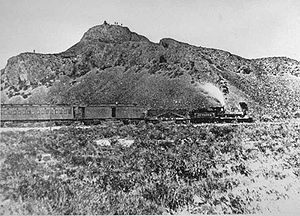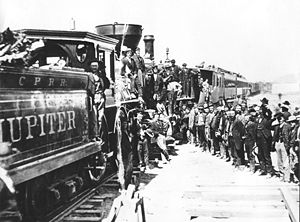.gif)
Jupiter (locomotive)
Encyclopedia
The Jupiter was a 4-4-0
steam locomotive which made history as one of the two locomotives (the other being the Union Pacific No. 119
) to meet at Promontory Summit during the Golden Spike
ceremony commemorating the completion of the First Transcontinental Railroad
.
The Jupiter was built in September, 1868 by the Schenectady Locomotive Works
of New York, along with three other engines: the Storm, Leviathan and Whirlwind. These four engines were then dismantled and sailed to San Francisco, CA where they were loaded onto a river barge and sent to the Central Pacific headquarters in Sacramento, then reassembled and commissioned into service on March 20, 1869.
The Jupiter was a wood burning locomotive. The distinctive conical chimney, known as a 'balloon stack', contained a spark arrestor.
 The Jupiter was not Leland Stanford
The Jupiter was not Leland Stanford
's original choice for transporting his party to the Golden Spike site. Originally, Stanford's train was to be pulled by another Central Pacific locomotive, the Antelope. For some distance, this train followed closely behind a regularly scheduled train pulled by the Jupiter. However, at one point the two trains were to go through a cut where a logging camp resided atop the hill. There, the workers apparently did not notice the Jupiters small flag which indicated another train is closely following. After the Jupiter passed, the workers rolled a large log down the mountain, which struck the Antelope. With the engine damaged, a message was sent to the upcoming station to hold the approaching train. There, Stanford's consist was added to the Jupiters train.

's Genoa locomotive, to celebrate the road's legacy at various events, such as the Chicago Railroad Fair
.
In 1969, another stand-in for the Jupiter was placed on display, this one at the Golden Spike National Historic Site
to celebrate the centennial of the Golden Spike
. In this instance, the engine was portrayed by Virginia and Truckee's Inyo
and the engine remained on display until its sale to the state of Nevada in 1974.
Meanwhile, the National Park Service
had approached O'Connor Engineering Laboratories of Costa Mesa, California to construct exact, full-size replicas of the Jupiter and Union Pacific 119. Original drawings of the engines have not been preserved, so the firm had to construct new drawings based on enlarged photographs of the engines and an 1870's vintage locomotive design handbook.
The replicas began operating May 10, 1979, and continue to make demonstration runs.
4-4-0
Under the Whyte notation for the classification of steam locomotives, 4-4-0 represents the wheel arrangement of four leading wheels on two axles , four powered and coupled driving wheels on two axles, and no trailing wheels...
steam locomotive which made history as one of the two locomotives (the other being the Union Pacific No. 119
Union Pacific No. 119
The No. 119 was a 4-4-0 steam locomotive which made history as one of the two locomotives to meet at Promontory Summit during the Golden Spike ceremony commemorating the completion of the First Transcontinental Railroad.No...
) to meet at Promontory Summit during the Golden Spike
Golden spike
The "Golden Spike" is the ceremonial final spike driven by Leland Stanford to join the rails of the First Transcontinental Railroad across the United States connecting the Central Pacific and Union Pacific railroads on May 10, 1869, at Promontory Summit, Utah Territory...
ceremony commemorating the completion of the First Transcontinental Railroad
First Transcontinental Railroad
The First Transcontinental Railroad was a railroad line built in the United States of America between 1863 and 1869 by the Central Pacific Railroad of California and the Union Pacific Railroad that connected its statutory Eastern terminus at Council Bluffs, Iowa/Omaha, Nebraska The First...
.
The Jupiter was built in September, 1868 by the Schenectady Locomotive Works
Schenectady Locomotive Works
The Schenectady Locomotive Works built railroad locomotives from its founding in 1848 through its merger into American Locomotive Company in 1901.After the 1901 merger, ALCO made the Schenectady plant its headquarters in Schenectady, New York....
of New York, along with three other engines: the Storm, Leviathan and Whirlwind. These four engines were then dismantled and sailed to San Francisco, CA where they were loaded onto a river barge and sent to the Central Pacific headquarters in Sacramento, then reassembled and commissioned into service on March 20, 1869.
The Jupiter was a wood burning locomotive. The distinctive conical chimney, known as a 'balloon stack', contained a spark arrestor.
Golden Spike Ceremony

Leland Stanford
Amasa Leland Stanford was an American tycoon, industrialist, robber baron, politician and founder of Stanford University.-Early years:...
's original choice for transporting his party to the Golden Spike site. Originally, Stanford's train was to be pulled by another Central Pacific locomotive, the Antelope. For some distance, this train followed closely behind a regularly scheduled train pulled by the Jupiter. However, at one point the two trains were to go through a cut where a logging camp resided atop the hill. There, the workers apparently did not notice the Jupiters small flag which indicated another train is closely following. After the Jupiter passed, the workers rolled a large log down the mountain, which struck the Antelope. With the engine damaged, a message was sent to the upcoming station to hold the approaching train. There, Stanford's consist was added to the Jupiters train.

Later career
The Jupiter continued in service for the Central Pacific R.R. In the 1870s, the railroad decided to end their practice of naming their engines, and thus, the Jupiter name was dropped and the engine was simply known as C.P. #60. The locomotive also received many new upgrades such as a new boiler, cowcatcher, domes, and smokestack. In 1891, the Southern Pacific, which acquired the Central Pacific in 1885, began renumbering its locomotives. As part of this renumbering, the former "Jupiter" engine #60 became S.P. #1195. In 1893 it was converted to burn coal, and later that year was sold to the Gila Valley, Globe and Northern R.R. and designated GVG & N #1. In 1909 the locomotive which no longer resembled the original Jupiter was sold to scrappers for $1,000.Later Reproductions
The Southern Pacific had not acknowledged the Jupiter's significance until well after the engine had been scrapped. The railroad later used a stand-in for the Jupiter, usually Virginia and Truckee RailroadVirginia and Truckee Railroad
The Virginia and Truckee Railroad was built to serve the Comstock Lode mining communities of northwestern Nevada. At its height, the railroad's route ran from Reno south to Carson City, Nevada. In Carson City, the...
's Genoa locomotive, to celebrate the road's legacy at various events, such as the Chicago Railroad Fair
Chicago Railroad Fair
The Chicago Railroad Fair was an event organized to celebrate and commemorate 100 years of railroad history west of Chicago, Illinois. It was held in Chicago in 1948 and 1949 along the shore of Lake Michigan, and is often referred to as "the last great railroad fair" with 39 railroad companies...
.
In 1969, another stand-in for the Jupiter was placed on display, this one at the Golden Spike National Historic Site
Golden Spike National Historic Site
Golden Spike National Historic Site is a U.S. National Historic Site located at Promontory Summit, north of the Great Salt Lake in Utah.It commemorates the completion of the first Transcontinental Railroad where the Central Pacific Railroad and the Union Pacific Railroad met on May 10, 1869...
to celebrate the centennial of the Golden Spike
Golden spike
The "Golden Spike" is the ceremonial final spike driven by Leland Stanford to join the rails of the First Transcontinental Railroad across the United States connecting the Central Pacific and Union Pacific railroads on May 10, 1869, at Promontory Summit, Utah Territory...
. In this instance, the engine was portrayed by Virginia and Truckee's Inyo
Virginia and Truckee RR. Engines No. 18, The Dayton; and No. 22, The Inyo
The Virginia and Truckee Railroad Engines No. 18, The Dayton; and No. 22, The Inyo are two historic standard gauge steam locomotives. The Inyo is on display at the Nevada State Railroad Museum and the Dayton is on display in Virginia City, Nevada...
and the engine remained on display until its sale to the state of Nevada in 1974.
Meanwhile, the National Park Service
National Park Service
The National Park Service is the U.S. federal agency that manages all national parks, many national monuments, and other conservation and historical properties with various title designations...
had approached O'Connor Engineering Laboratories of Costa Mesa, California to construct exact, full-size replicas of the Jupiter and Union Pacific 119. Original drawings of the engines have not been preserved, so the firm had to construct new drawings based on enlarged photographs of the engines and an 1870's vintage locomotive design handbook.
The replicas began operating May 10, 1979, and continue to make demonstration runs.

